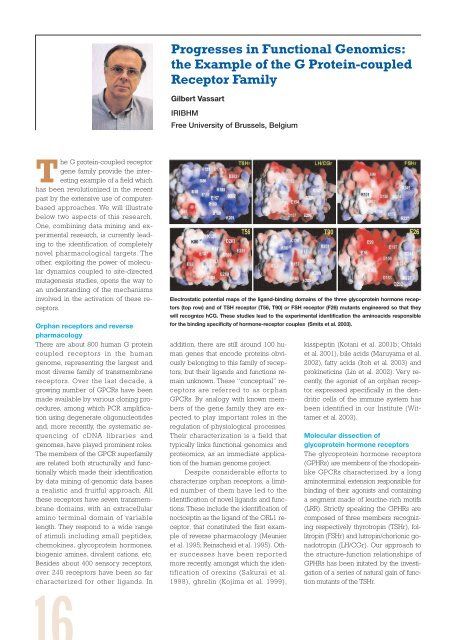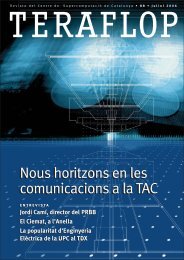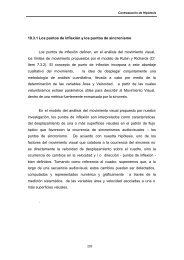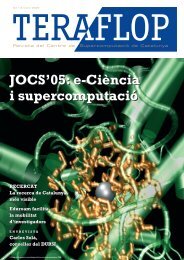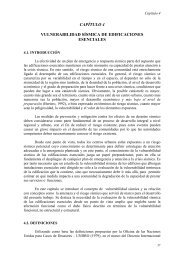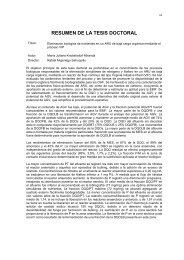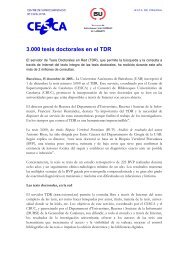Teraflop 73 - Novembre - cesca
Teraflop 73 - Novembre - cesca
Teraflop 73 - Novembre - cesca
You also want an ePaper? Increase the reach of your titles
YUMPU automatically turns print PDFs into web optimized ePapers that Google loves.
The G protein-coupled receptor<br />
gene family provide the interesting<br />
example of a field which<br />
has been revolutionized in the recent<br />
past by the extensive use of computerbased<br />
approaches. We will illustrate<br />
below two aspects of this research.<br />
One, combining data mining and experimental<br />
research, is currently leading<br />
to the identification of completely<br />
novel pharmacological targets. The<br />
other, exploiting the power of molecular<br />
dynamics coupled to site-directed<br />
mutagenesis studies, opens the way to<br />
an understanding of the mechanisms<br />
involved in the activation of these receptors.<br />
Orphan receptors and reverse<br />
pharmacology<br />
There are about 800 human G protein<br />
coupled receptors in the human<br />
genome, representing the largest and<br />
most diverse family of transmembrane<br />
receptors. Over the last decade, a<br />
growing number of GPCRs have been<br />
made available by various cloning procedures,<br />
among which PCR amplification<br />
using degenerate oligonucleotides<br />
and, more recently, the systematic sequencing<br />
of cDNA libraries and<br />
genomes, have played prominent roles.<br />
The members of the GPCR superfamily<br />
are related both structurally and functionally<br />
which made their identification<br />
by data mining of genomic data bases<br />
a realistic and fruitful approach. All<br />
these receptors have seven transmembrane<br />
domains, with an extracellular<br />
amino terminal domain of variable<br />
length. They respond to a wide range<br />
of stimuli including small peptides,<br />
chemokines, glycoprotein hormones,<br />
biogenic amines, divalent cations, etc.<br />
Besides about 400 sensory receptors,<br />
over 240 receptors have been so far<br />
characterized for other ligands. In<br />
Progresses in Functional Genomics:<br />
the Example of the G Protein-coupled<br />
Receptor Family<br />
Gilbert Vassart<br />
IRIBHM<br />
Free University of Brussels, Belgium<br />
Electrostatic potential maps of the ligand-binding domains of the three glycoprotein hormone receptors<br />
(top row) and of TSH receptor (T56, T90) or FSH receptor (F26) mutants engineered so that they<br />
will recognize hCG. These studies lead to the experimental identification the aminoacids responsible<br />
for the binding specificity of hormone-receptor couples (Smits et al. 2003).<br />
addition, there are still around 100 human<br />
genes that encode proteins obviously<br />
belonging to this family of receptors,<br />
but their ligands and functions remain<br />
unknown. These “conceptual” receptors<br />
are referred to as orphan<br />
GPCRs. By analogy with known members<br />
of the gene family they are expected<br />
to play important roles in the<br />
regulation of physiological processes.<br />
Their characterization is a field that<br />
typically links functional genomics and<br />
proteomics, as an immediate application<br />
of the human genome project.<br />
Despite considerable efforts to<br />
characterize orphan receptors, a limited<br />
number of them have led to the<br />
identification of novel ligands and functions.<br />
These include the identification of<br />
nociceptin as the ligand of the ORL1 receptor,<br />
that constituted the first example<br />
of reverse pharmacology (Meunier<br />
et al. 1995; Reinscheid et al. 1995). Other<br />
successes have been reported<br />
more recently, amongst which the identification<br />
of orexins (Sakurai et al.<br />
1998), ghrelin (Kojima et al. 1999),<br />
kisspeptin (Kotani et al. 2001b; Ohtaki<br />
et al. 2001), bile acids (Maruyama et al.<br />
2002), fatty acids (Itoh et al. 2003) and<br />
prokineticins (Lin et al. 2002). Very recently,<br />
the agonist of an orphan receptor<br />
expressed specifically in the dendritic<br />
cells of the immune system has<br />
been identified in our Institute (Wittamer<br />
et al. 2003).<br />
Molecular dissection of<br />
glycoprotein hormone receptors<br />
The glycoprotein hormone receptors<br />
(GPHRs) are members of the rhodopsinlike<br />
GPCRs characterized by a long<br />
aminoterminal extension responsible for<br />
binding of their agonists and containing<br />
a segment made of leucine-rich motifs<br />
(LRR). Strictly speaking the GPHRs are<br />
composed of three members recognizing<br />
respectively thyrotropin (TSHr), follitropin<br />
(FSHr) and lutropin/chorionic gonadotropin<br />
(LH/CGr). Our approach to<br />
the structure-function relationships of<br />
GPHRs has been initated by the investigation<br />
of a series of natural gain of function<br />
mutants of the TSHr.


